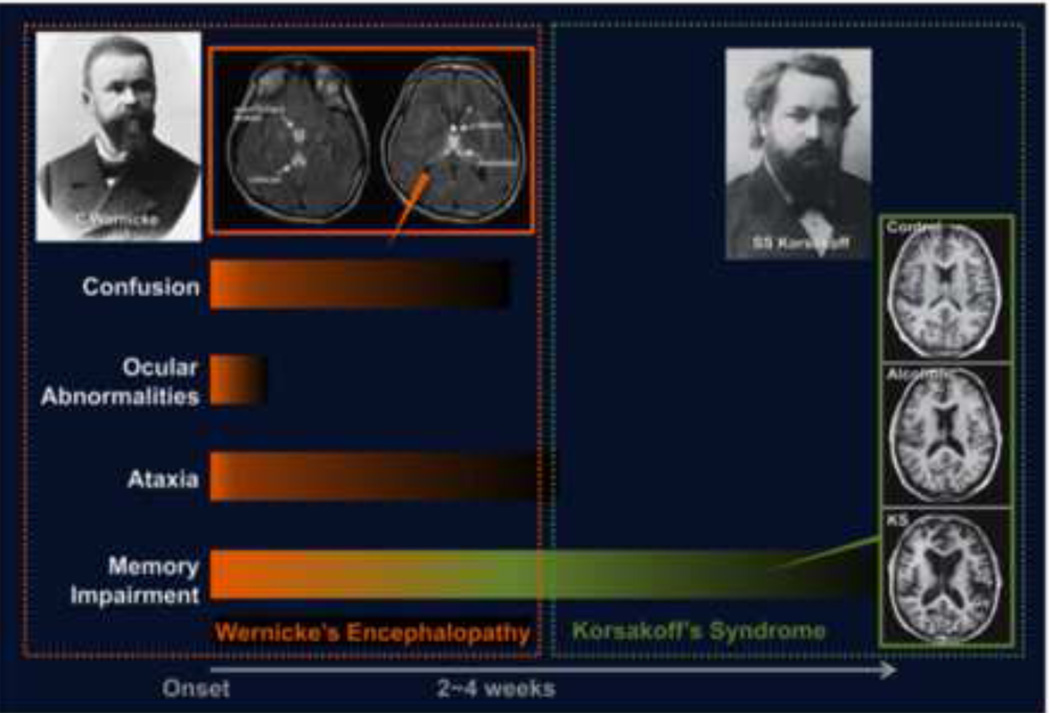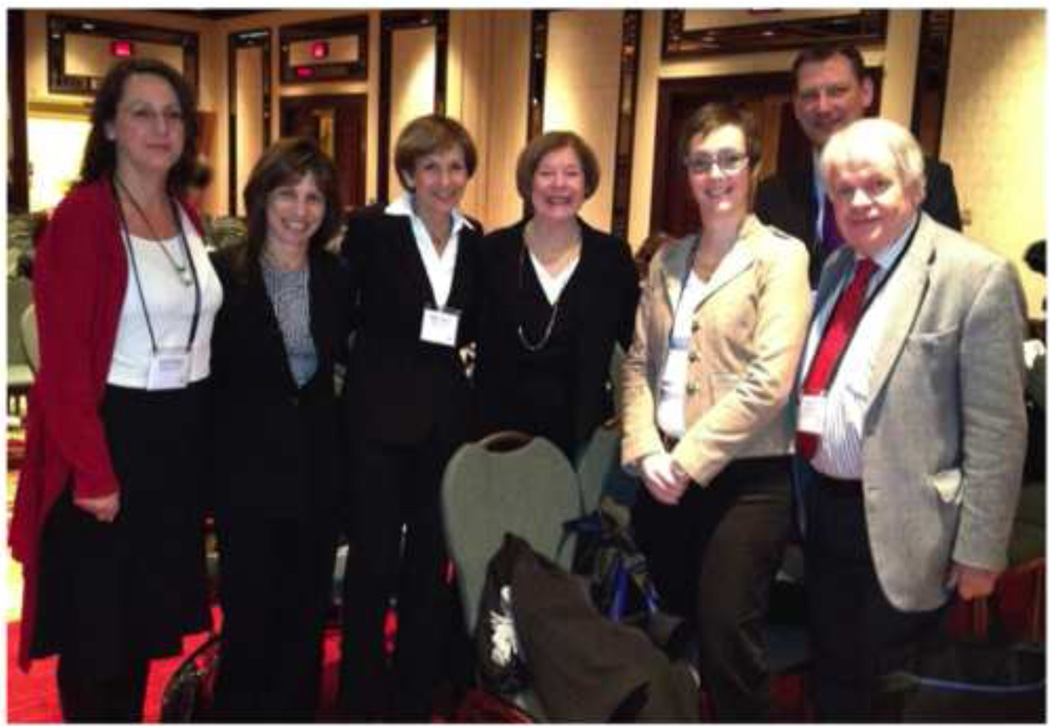Wernicke's Encephalopathy (WE) and Korsakoff's Syndrome (KS): Brief history and linkage
Carl Wernicke, a German neurologist, published the formal description of the encephalopathy for whom it is named 131 years ago. The clinical symptoms included lethargy, ophthalmoplegia, ataxia, and mental compromise. Within the same decade but unaware of Wernicke's description, Sergei Korsakoff, a Russian psychiatrist, presented his doctoral dissertation, "Alcoholic Paralysis," on the circumscribed amnesia occurring in certain cases of chronic alcoholism. More than half a century lapsed before the common etiology of thiamine deficiency was discovered as the cause of the signs, symptoms, and link between these conditions (for historical reviews, see Charness, Simon, & Greenberg, 1989; Victor, Adams, & Collins, 1989). We now acknowledge the temporal linkage of Wernicke's Encephalopathy (WE) and Korsakoff's Syndrome (KS), depicted in Fig. 1 (cover image): 1) the acute phase of the encephalopathy, which results in bilateral lesions of periventricular nuclei, thalami, and structures of Papez's circuit, notably the mammillary bodies; and 2) the chronic phase of the syndrome, which resolves into relatively permanent bilateral lesions and enduring global amnesia. In recognition of this linkage, the resulting condition is often referred to as the Wernicke-Korsakoff Syndrome (WKS). The profound amnesia provided a compelling link to neuropsychology and set the stage for dissecting memory's component processes and identifying its dissociable neural substrates.
Fig. 1.
Depiction of the temporal progression of signs of Wernicke's Encephalopathy and its radiological signature of hyperintense areas, indicative of edematous tissue, in midline structures, and resolution to global amnesia and permanent structural damaged, most obviously marked by enlarged ventricular and sulcal spaces. Designed by Young-Chul Jung, M.D., Ph.D.
Why is study of WE and KS still important?
Thiamine, also known as Vitamin B1, is an essential nutrient obtained only from diet and cannot be synthesized by animals. B1 depletion is the cause of WKS as well as other conditions, including beriberi. Even though treatment and prevention are straightforward, diagnosis is often missed because the presenting signs, notably malaise, irritability, and confusion, are common to a broad spectrum of other conditions.
Just 3 years ago, Zuccoli and Pipitone (Zuccoli & Pipitone, 2009) wrote, "Autopsy studies have consistently shown that the diagnosis of WE is often made only postmortem, particularly when patients present with atypical clinical manifestations (Harper, 1979; Harper, 1983; Harper, Giles, & Finlay-Jones, 1986; Lindboe & Loberg, 1989; Thomson et al., 2008; Torvik, Lindboe, & Rodge, 1982). For instance, in patients with alcoholism and AIDS, WE diagnosis is missed in as many as 75–80% of all patients (Butterworth et al., 1991)" (page 501). Given the high prevalence of alcoholism (www.niaaa.nih.gov) and AIDS (www.aids.gov/hiv-aids-basics/hiv-aids-101/overview/statistics/) and the growing number of other causes of WE, including bariatric surgery for obesity (www.cdc.gov/obesity/adult/defining.html), neuropsychology, neurology, neuroradiology, internal medicine, and other related disciplines need to instate in their featured differential diagnosis the possibility of WE in cases involving such conditions and potential nutritional insufficiencies, including anorexia nervosa, bulimia, hyperemesis gravidarum, and bariatric surgery.
Overview of papers in this issue
Like Gaul, this issue is divided into three parts: 1) neuroanatomy and treatment of WE and KS; 2) the role of KS in identifying component processes of memory and considerations of nonmnemonic contributions to the memory impairment; and 3) diagnosis supplemented by neuroradiological signs and medical symptoms with confirmation from animal models.
1. Neuropathology and treatment of WE and KS
Kril and Harper, the foremost neuropathologists in this field, present a thorough review of the neuropathology resulting in the depiction of the neuroanatomy of WE and KS ("Neuroanatomy and neuropathology associated with Korsakoff's Syndrome"). Following from their discovery through postmortem investigations that WE is under-diagnosed in life, Dr. Harper was instrumental in instituting the national policy of enriching bread goods with thiamine in Australia, his homeland (see Meet the Researcher Clive Harper at www.rsoa.org/ProfileHarper.htm). Thomson, Guerrini, and Marshall ("The evolution and treatment of Korsakoff's syndrome") provide a clear case for the medical understanding of the sequelae and physiological mechanisms of WE and KS, describe the physiology of thiamine deficiency in the context of chronic alcoholism, and highlight the value of case studies in identifying the variety of presentations and etiologies of the common cause—thiamine deficiency.
2. The role of KS in identifying component processes of memory
This set of papers marches through the dissociable component processes of memory identified by rigorous study of patients with alcoholic KS. Each paper is devoted to a principal mnemonic component: Anterograde episodic memory in Korsakoff syndrome (Fama, Pitel, and Sullivan); Remote memory function and dysfunction in Korsakoff’s syndrome (Race and Verfaellie); Context memory in Korsakoff's syndrome (Kessels and Kopelman); and Implicit memory in Korsakoff's syndrome: a review of procedural learning and priming studies (Hayes, Fortier, Levine, Milberg, and McGlinchey). The paper, "KS Function and dysfunction of prefrontal brain circuitry in alcoholic Korsakoff’s syndrome," by Oscar-Berman (see Meet the Researcher Marlene Oscar-Berman at http://www.rsoa.org/news.htm) is relevant in providing novel considerations of nonmnemonic processes and neuroanatomical substrates and circuitry affected in KS and their contribution to the clinical picture and memory processes affected.
3. Diagnosis of WE and KS by neuroradiological signs and medical symptoms with confirmation through animal models
Jung, Chanraud, and Sullivan ("Neuroimaging of Wernicke's encephalopathy and Korsakoff's syndrome") review the in vivo studies of WE and KS, indicating convergence with postmortem findings and neuropsychological assessment. Taken from the perspective of an Intensive Care Unit nurse and clinical researcher, the paper by Lough ("Wernicke’s encephalopathy: expanding the diagnostic toolbox") describes a large series of published case reports of WE and suggests tools that could promote accurate diagnosis. Finally, Savage, Hall, and Resende present a review of their elegant experiments, confirming the mechanism of WE and KS through rodent models; the title of their paper summarizes its objectives: "Translational rodent models of Korsakoff syndrome reveal the critical neuroanatomical substrates of memory dysfunction and recovery."
4. INS 2012 symposium and photos
For fun, we have included a cell phone photo (Fig. 2) taken at our symposium entitled, "Korsakoff Syndrome Revisited: Neuroimaging and Translational Investigations," presented at the February 2012 annual meeting of the International Neuropsychological Society in Montreal, Canada. This symposium featured a number of the authors of the current issue of Neuropsychology Review and served as a precursor to the papers herein.
Fig. 2.
Speakers in the symposium entitled, "Korsakoff Syndrome Revisited: Neuroimaging and Translational Investigations," presented at the February 2012 annual meeting of the International Neuropsychological Society in Montreal, Canada. Left to right: Lisa Savage, Rosemary Fama, Edith Sullivan, Marlene Oscar-Berman, Anne-Lise Pitel, Roy Kessels, and Michael Kopelman.
Acknowledgments
This work was supported by grants from the NIAAA (AA010723, AA017168, AA017923).
Footnotes
Disclosures
The author is the editor-in-chief of the journal.
REFERENCES
- Butterworth RF, Gaudreau C, Vincelette J, Bourgault AM, Lamothe F, Nutini AM. Thiamine deficiency and Wernicke's encephalopathy in AIDS. Metab Brain Dis. 1991;6(4):207–212. doi: 10.1007/BF00996920. [DOI] [PubMed] [Google Scholar]
- Charness ME, Simon RP, Greenberg DA. Ethanol and the nervous system. New England Journal of Medicine. 1989;321(7):442–453. doi: 10.1056/NEJM198908173210706. [DOI] [PubMed] [Google Scholar]
- Harper C. Wernicke's encephalopathy: A more common disease than realized. A neuropathological study of 51 cases. Journal of Neurology, Neurosurgery, and Psychiatry. 1979;42:226–232. doi: 10.1136/jnnp.42.3.226. [DOI] [PMC free article] [PubMed] [Google Scholar]
- Harper CG. The incidence of Wernicke's encephalopathy in Australia: A neuropathological study of 131 cases. Journal of Neurology, Neurosurgery, and Psychiatry. 1983;46:593–598. doi: 10.1136/jnnp.46.7.593. [DOI] [PMC free article] [PubMed] [Google Scholar]
- Harper CG, Giles M, Finlay-Jones R. Clinical signs in the Wernicke-Korsakoff complex: a retrospective analysis of 131 cases diagnosed at necropsy. Journal of Neurology Neurosurgery and Psychiatry. 1986;49(4):341–345. doi: 10.1136/jnnp.49.4.341. [DOI] [PMC free article] [PubMed] [Google Scholar]
- Lindboe CF, Loberg EM. Wernicke's encephalopathy in non-alcoholics. An autopsy study. J Neurol Sci. 1989;90(2):125–129. doi: 10.1016/0022-510x(89)90095-6. [DOI] [PubMed] [Google Scholar]
- Thomson AD, Cook CC, Guerrini I, Sheedy D, Harper C, Marshall EJ. Wernicke's encephalopathy: 'Plus ca change, plus c'est la meme chose'. Alcohol Alcohol. 2008;43(2):180–186. doi: 10.1093/alcalc/agm149. [DOI] [PubMed] [Google Scholar]
- Torvik A, Lindboe CF, Rodge S. Brain lesions in alcoholics: A neuropathological study with clinical correlations. Journal of the Neurological Sciences. 1982;56:233–248. doi: 10.1016/0022-510x(82)90145-9. [DOI] [PubMed] [Google Scholar]
- Victor M, Adams RD, Collins GH. The Wernicke-Korsakoff Syndrome and Related Neurologic Disorders Due to Alcoholism and Malnutrition. 2. Philadelphia: F.A. Davis Co.; 1989. [Google Scholar]
- Zuccoli G, Pipitone N. Neuroimaging findings in acute Wernicke's encephalopathy: review of the literature. AJR Am J Roentgenol. 2009;192(2):501–508. doi: 10.2214/AJR.07.3959. [DOI] [PubMed] [Google Scholar]




